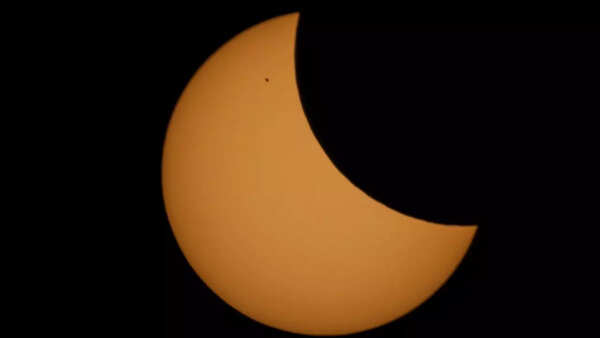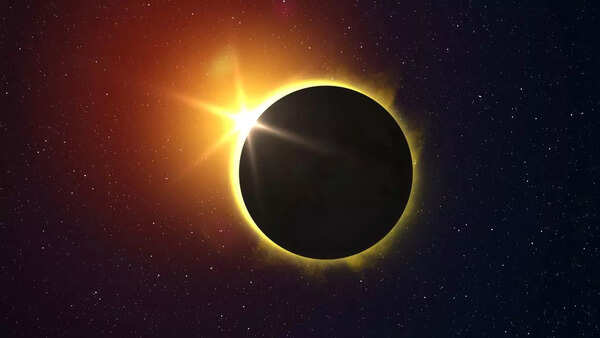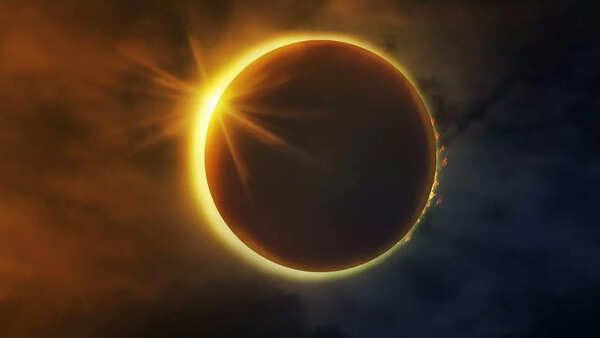What causes a solar eclipse? The science behind it

On March 29, 2025, skywatchers around the world will get the chance to witness a fascinating astronomical event: a partial solar eclipse. During this event, the Moon will align in such a way that it will partially block the Sun‘s light, casting a shadow on Earth.
While this particular eclipse will not be visible from India, the scientific principles behind this event are worth exploring. Solar eclipses are some of the most awe-inspiring natural phenomena, but have you ever wondered why they happen? In this article, we delve into the science behind a solar eclipse, explaining how this rare event unfolds and the celestial movements that make it possible.
What is a solar eclipse?
A solar eclipse happens when the Moon moves between the Earth and the Sun, briefly blocking sunlight from reaching certain areas, as explained in a NASA report. This creates a breathtaking visual effect, with the Sun appearing either fully or partially covered, depending on your location. For this to occur, the Sun, Moon, and Earth must align in a precise way. However, it’s not just about their positions– their sizes and distances also determine the type of eclipse we experience.
How does the alignment work?

For a solar eclipse to occur, the Sun, Earth, and Moon must be in alignment. However, the Moon’s orbit is not perfectly aligned with Earth’s orbit around the Sun, which is why solar eclipses don’t occur every month.
As explained by NASA, the Moon’s orbit is tilted by about 5 degrees, so most of the time, it either passes above or below the Sun in the sky. Eclipses only happen when the new moon– the phase when the Moon is positioned between Earth and the Sun– happens during an alignment along what is known as the ecliptic plane, a path that Earth follows around the Sun.
Types of solar eclipses
Depending on the alignment of the Sun, Moon, and Earth, several types of solar eclipses can occur:
Total solar eclipse
In a total solar eclipse, the Moon completely covers the Sun, blocking all its light. This rare event occurs when the Moon is closer to Earth in its orbit, making it appear large enough in the sky to fully obscure the Sun. For observers in the umbra, the darkest part of the Moon’s shadow, the sky will go completely dark for a brief period, allowing the corona (the Sun’s outer atmosphere) to be seen. A total eclipse is a breathtaking display that can only be experienced from a narrow path on Earth known as the path of totality.

Annular solar eclipse
An annular eclipse occurs when the Moon is farther from Earth, appearing smaller in the sky. This distance prevents the Moon from completely covering the Sun, and as a result, the Sun’s outer edges remain visible around the Moon, forming a ring of light often referred to as the “Ring of Fire”. The region where this annular eclipse is visible is called the path of annularity.
Hybrid solar eclipse
A hybrid solar eclipse is a rare type that combines elements of both total and annular eclipses. The path of totality and the path of annularity overlap in some locations, so in some areas, observers will see a total eclipse, while others will witness the annular effect. These hybrid eclipses are not commonly seen, but they offer an intriguing visual experience.
Partial solar eclipse
A partial solar eclipse occurs when the Moon only partially blocks the Sun. In this case, the Moon’s shadow falls on Earth as a penumbra, or the lighter part of the shadow. Observers who are within this region will see the Sun as a crescent or a sliver, depending on how much of it is covered by the Moon. A partial eclipse is the most common type of solar eclipse.
Why don’t solar eclipses happen every month?
Although a new moon occurs roughly every month, a solar eclipse doesn’t happen every time because of the Moon’s tilted orbit. The Moon orbits Earth at a 5-degree angle relative to Earth’s orbit around the Sun.

This means that during most new moons, the Moon is either slightly above or below the Sun, missing the Earth entirely. Solar eclipses only happen when the Moon crosses the ecliptic plane, which occurs during the eclipse seasons, approximately twice a year.
The 2025 solar eclipses: What to expect
In 2025, two significant solar eclipses will occur: a partial solar eclipse on March 29, and an annular solar eclipse on September 21, media reports suggest. Unfortunately, these eclipses will not be visible in India.
While the March 29 eclipse will only be a partial one, the September event promises the “Ring of Fire” effect, as the Moon will appear slightly smaller than the Sun, creating a breathtaking ring of sunlight around its edges. While India will not witness these eclipses, people around the world can enjoy the visual display, especially those in regions where the eclipse path will pass.
Solar eclipses and cultural significance in India
In India, a solar eclipse, or Surya Grahan, holds both cultural and religious significance. Many believe that the eclipse has a profound effect on health and spiritual well-being. As such, it’s common for people to engage in specific rituals during an eclipse, such as fasting, praying, or staying indoors.
While some view the eclipse as a moment of cosmic cleansing, others associate it with negative energy, encouraging protective practices. Despite these beliefs, scientists emphasize that an eclipse is simply a natural event with no harmful effects.
In a nutshell, solar eclipses are some of the most fascinating events in the sky, showcasing the precise movements of our solar system. Whether it’s a total eclipse, where the Sun is completely covered, or an annular eclipse, leaving a glowing ring, these celestial events are both stunning and scientifically important.
Understanding how the Moon, Earth, and Sun align to create an eclipse helps us appreciate just how rare and remarkable they are. So, the next time a solar eclipse occurs– whether you can see it or not– you’ll have a deeper insight into the cosmic alignment behind it!



